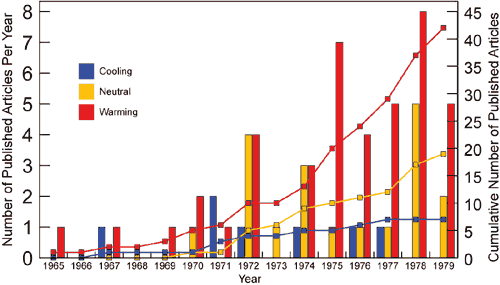
Figure 1: Number of papers classified as predicting global cooling (blue) or warming (red). From Peterson 2008.
In an opinion article for The Washington Post about the impending automatic budget sequestration in the USA, George Will inexplicably compared the situation to the long-debunked climate myth of an ice age predicted in the 1970s. In the article, Will argues that President Obama and American liberals are effectively "crying wolf" about the effects of the sequestration on the economy, and compares the situation to supposed predictions of impending cooling made in the 1970s.
In reality, a survey of peer reviewed scientific papers from 1965 to 1979 showed that fewer than 10% papers predicted global cooling while significantly more papers (62%) predicted global warming (Peterson 2008; Figure 1).

Figure 1: Number of papers classified as predicting global cooling (blue) or warming (red). From Peterson 2008.
So how does Will argue otherwise? See if you can spot the similarity between most of the sources he cites to support this myth:
"Remember when “a major cooling of the climate” was “widely considered inevitable” (New York Times, May 21, 1975) with “extensive Northern Hemisphere glaciation” (Science magazine, Dec. 10, 1976) which must “stand alongside nuclear war as a likely source of wholesale death and misery” (International Wildlife, July 1975)? Remember reports that “the world’s climatologists are agreed” that we must “prepare for the next ice age” (Science Digest, February 1973)? Armadillos were leaving Nebraska, heading south, and heat-loving snails were scampering southward from European forests (Christian Science Monitor, Aug. 27, 1974). Newsweek (April 28, 1975) said meteorologists were “almost unanimous” that cooling would “reduce agricultural productivity.”
The New York Times, International Wildlife, Science Digest, Christian Science Monitor, and Newsweek – these are all mainstream newspaper and magazine sources, not peer-reviewed scientific journals. The one exception is a study published in Science magazine by Hays, Imbrie, and Shackleton (1976); however, the paper investigated the Earth's orbital cycles which operate on timescales of tens to hundreds of thousands of years (emphasis added to the portion of the quote Will conveniently left out):
"...the results indicate that the long-term trend over the next 20,000 years is towards extensive Northern Hemisphere glaciation and cooler climate"
Will has badly misrepresented their study by claiming that Hays et al. were predicting an impending ice age.
Perhaps the worst part of Will's argument is that he has been repeating the same myth for years and years. As the Center for American Progress has documented, Will made the same argument, citing the same references in 1992, 1997, 2004, 2006, 2009, and now again in 2013. The climate scientists at RealClimate debunked Will repeating this myth using the same sources in January of 2005, over eight years ago, as did Gilbert Martinez in 2006, and Brad Johnson in 2009.
But apparently Will has refused to learn a thing about this subject in the past 21 years.
Obviously there was some basis to the media stories Will cites; as Peterson (2008) noted, there were a few scientific papers predicting potential global cooling in the 1970s. Perhaps the most famous such paper was Rasool and Schneider (1971):
"An increase by only a factor of 4 in global aerosol background concentration may be sufficient to reduce the surface temperature by as much as 3.5°K."
Yes, their global cooling projection was based on a quadrupling of atmospheric aerosol concentration (aerosols cause cooling by blocking sunlight). This wasn't an entirely unrealistic scenario at the time – after all, sulfur dioxide (SO2) emissions were accelerating quite rapidly up until the early 1970s (Figure 2). These emissions caused various environmental and public health problems, and as a result, a number of countries, including the USA, started limiting SO2 emissions through Clean Air Acts. Consequently, not only did atmospheric aerosol concentrations not quadruple, but emissions even declined starting in the late 1970s:
Figure 2: Global sulfur dioxide emissions by source (PNNL)
As Peter Gleick recently discussed, there is a difference between a projection based on a possible scenario and a prediction. The possibility of global cooling in the 1970s was based on a conditional scenario in which human aerosol emissions continued to rise rapidly. That scenario did not actually occur.
Similarly, future global warming projections are based on various possible greenhouse gas emissions scenarios. If we can get our greenhouse gas emissions under control, we can limit future global warming as well.
It's difficult to understand why George Will keeps raising this climate myth from the dead. Perhaps he needed another 100 words to meet his quota. Perhaps he forgot the many times this myth has been debunked. Perhaps he wanted to add more controversy to his article.
Whatever the reason, it's very difficult to take George Will seriously if he can't learn from repeatedly making the same mistake over a period of two decades. The lesson to be learned here – aside from "stop repeating a myth at least a few years after it's been repeatedly debunked" – is that we should listen both to what climate scientists actually say, and their explanations for why they say it. Because unlike George Will, climate scientists know a thing or two about the climate.
Posted by dana1981 on Wednesday, 27 February, 2013
 |
The Skeptical Science website by Skeptical Science is licensed under a Creative Commons Attribution 3.0 Unported License. |